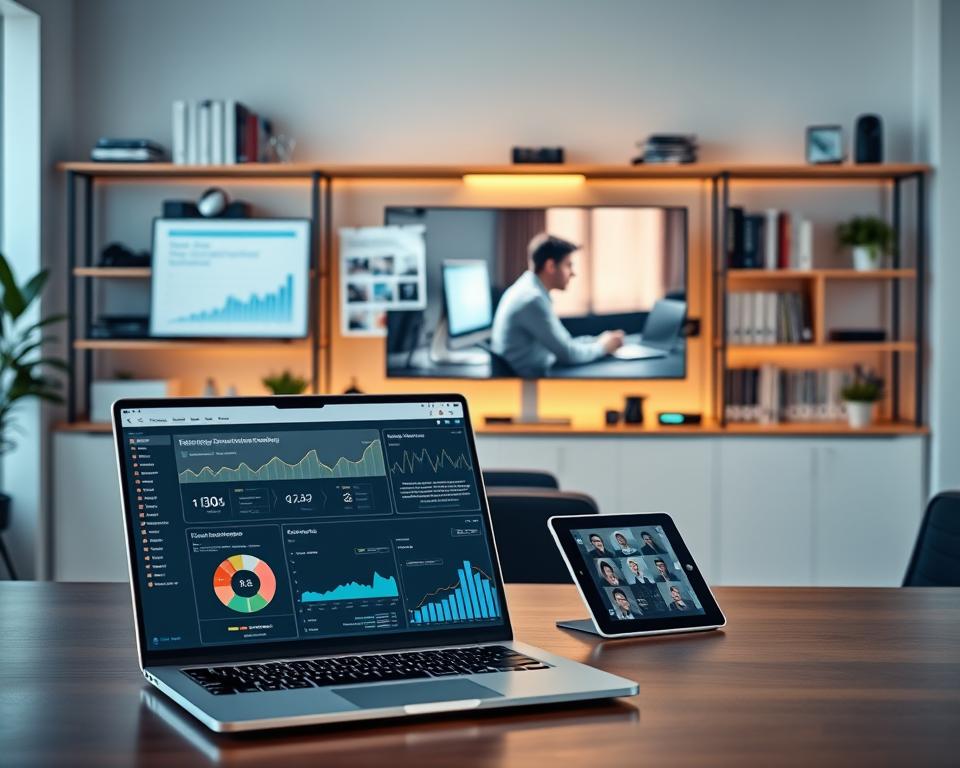Internal SEO Guide: Boost Your Website Standings
Do you find yourself without realizing undermining your webpage’s capacity to position more prominently on search platforms? The world of on-page SEO is intricate, with aspects that can either boost or hinder your web presence. A comprehensive on site SEO guide is not just a proposal; it’s a requirement to enhance your website’s presence and attract organic traffic. By utilizing targeted SEO optimization methods, you can create persuasive content that engages your audience. This guarantees your webpage follows best practices.
In this article, we’ll discuss vital webpage ranking advice frequently ignored. We’ll shed light on how systematic SEO tactics can substantially boost your site’s performance. From keyword positioning methods to analysis tools, we’ll arm you with the knowledge to improve your on site SEO.
Main Points
- An effective internal SEO list is vital for enhancing your webpage.
- Incorporating extended keywords can draw niche audience.
- Maintaining the caliber and applicability of your material improves SERP standings.
- Using resources like SEMrush and Ahrefs can reveal beneficial keywords.
- Optimizing title tags and meta descriptions substantially enhances click rates.
- Consistency in providing captivating and original content is essential to keeping your SEO edge.
- Regularly conduct keyword gap assessments to find additional enhancement possibilities.
Comprehending On-Page SEO
Internal SEO is a essential part of online marketing, concentrating on enhancing single webpages to enhance their search rankings. It entails a diversity of strategies to guarantee material is both pertinent and valuable to users. This approach follows SEO guidelines. You can learn about how to do local SEO for multiple locations
Definition of On-Page SEO?
On site SEO enhances components of a web page, including material, meta tags, URLs, and headings. A important part of internal SEO is the tactical application of search terms in these elements. For illustration, 90% of the instances, the primary keyword is embedded in the URL format. Google values appropriate words in links, supporting clean formats without unnecessary words.
Carefully designed title tags are essential for click rates. They must be brief and properly organized.
The Importance of On-Page SEO for Rankings
On site SEO is crucial for a site’s trustworthiness and visitor experience. Google emphasizes the value of matching site content with user intent. This alignment can lead to a 12x increase in search traffic.
High-ranking pages often address various connected subcategories, emphasizing the requirement of original and beneficial material. Google’s E-A-T criteria stress the importance of showing knowledge, skill, authority, and trust in information. Furthermore, using specific keyword phrases, developing detailed material, and efficient internal linking strategies can significantly boost internal SEO initiatives.
Essential Elements of Your On-Page SEO Checklist
On-page SEO is vital for enhancing a website’s visibility and efficiency in SERPs. Knowing the key components of SEO can significantly boost your site’s standing. This section outlines essential elements for an comprehensive on site SEO guide.
Title Tags and Meta Descriptions
Title tags and meta descriptions are vital for both. A properly designed title tag should be around 60 characters, including targeted keywords for clarity. Meta descriptions, though not a immediate ranking element, promote clicks by outlining content effectively. Best meta descriptions should be unique for each page, ideally around 150-160 characters long. These components not only enhance click-through rates but also better user experience.
Header Tags and Content Structure
Header tags, such as H1, H2, and H3, arrange content into a coherent format. Correct application of these tags enhances readability and leads users through the content. Header tags should include appropriate keywords, highlighting key themes. A coherent content structure assists both, leading to higher ranking and presence on SERPs.
Image Optimization
Images enhance engagement and make content more readable. Proper image optimization techniques are crucial to guarantee images aid SEO. This includes descriptive file names and alternative text that include target keywords. Additionally, compressing images improves load times, aiding both visitor satisfaction and website speed. Effective image optimization is a key component of SEO that can significantly enhance rankings when properly.
On-Page SEO Checklist: Essential Items
To thrive in on-page SEO, it’s essential to incorporate important steps that improve your website’s effectiveness. This section centers on successful keyword placement, the importance of content quality, and best internal linking practices. Each element is vital for enhanced visibility and audience participation.
Keyword Distribution Tactics
Successful keyword placement is key to improving your content. Employ long-tail keywords, which are keyword phrases with three or more words, as they achieve higher rankings. Focus on low-competition phrases for higher ranking chances. Furthermore, utilize keyword variations in post titles, SEO titles, and meta descriptions to reach more people. Google Autocomplete is a great tool to discover these variations, aiding in fulfilling user searches.
Content Quality and Relevance
Crafting detailed content that connects with your audience is essential. Employ a structured table of contents for extended articles to improve navigation. This can assist in appearing in Google’s jump-to links and featured snippets. Strive for succinct, informative content, especially in list formats, which Google favors. Tackling user queries through FAQ rich snippets can also help your site differentiate in search results.
Internal Linking Best Practices
Implementing effective internal linking strategies improves site navigation and promotes exploration. Incorporate internal and external links that add value to your visitors, increasing dwell time. Factor in insights from Facebook groups when planning content strategies. An successful internal linking structure maintains visitors involved and improves search engine visibility.
Using SEO Tools for Optimization
Effective on-page SEO strategies need the appropriate tools for evaluation and enhancement. Different SEO tools for optimization are essential, especially Google Analytics and Search Console. These tools offer insights into site efficiency, traffic sources, and visibility problems in search results.
Best Tools for On-Page SEO Analysis
Many tools are available to improve your on site SEO methods. Some important ones include:
- Google Analytics: Crucial for observing user behavior, page views, and traffic sources, enabling practical insights.
- Google Search Console: Crucial for tracking how your site is displayed in search results, diagnosing issues, and submitting sitemaps.
- SEMrush: A all-in-one platform for keyword research, site audits, and competitor analysis.
- Moz Pro: Useful for observing your site’s ranking and giving SEO recommendations to enhance visibility.
Steps to Set Up Google Analytics and Search Console
Setting up Google Analytics and Search Console is simple but requires attention to detail:
- Register for a Google Analytics account and input your website information.
- Follow the instructions to place the tracking code into your site’s code.
- Verify your property on Google Search Console by adding and validating your site.
- Submit your XML sitemap in Search Console to assist Google discover your pages.
With these tools in place, your website will enjoy detailed metrics and analysis. This creates the groundwork for data-driven SEO strategies that enhance overall website ranking capability.
Top SEO Methods for Content Creation
Crafting content that connects with your readers needs a planned approach. Optimal SEO strategies guarantee your content engages readers and achieves high rankings in search engine results. Developing beneficial content that meets user needs is central to this process.
Crafting Interesting and Beneficial Content
To create valuable content, focus on offering information that answers exact questions or addresses challenges for your visitors. Use the following strategies:
- Include primary and secondary keywords naturally throughout the text.
- Employ short sentences and subheadings to improve readability.
- Include bullet points and visuals to separate dense text and provide clarity.
- Make sure your content aligns with the search intent of your target audience.
Adapting content to meet user needs increases engagement and grows organic traffic. Content that meets user challenges often results in greater satisfaction and retention rates.
Syncing Content with Search Purpose
Understanding search intent is crucial when crafting content. This entails recognizing what users are seeking when they type particular searches. Follow these actions to align your content with search intent:
- Research keywords using tools like Google Autocomplete to find long-tail keyword keywords.
- Examine top-ranking pages on SERPs to learn content structure, style, and focus.
- Factor in user feedback, such as comments and discussions from relevant communities, to enhance content approaches.
- Utilize alt text for images and descriptive URLs that include the content’s main topic.
By focusing on useful content and aligning it with search intent, you enhance your site’s visibility. Applying these optimal SEO strategies can lead to improved standings and increased traffic. This establishes a win-win scenario for both users and search engines.
Technical Improvements for On-Page SEO
To improve your website’s SEO, focusing on technical enhancements is key. A significant factor is page load speed. Research indicates that about 50% of users exit if a site takes longer than 3 seconds to appear. Thus, approaches to cut down loading time are crucial for keeping users and boosting rankings.
Enhancing Page Speed
Optimizing page load speed is crucial for a better user experience. Here are some effective strategies to reach this:
- Make sure server response time is under 200ms for optimal performance. Regularly test and fix any speed problems.
- Employ image optimization like compressing files and using lossless formats like PNG. For dynamic images, transform GIFs to PNG.
- Delete redundant metadata from images. Store them in formats like JPEG2000 or WEBP for improved performance.
- Reduce render-blocking JavaScript and CSS. This reduces postponements in loading content visible area.
Mobile Responsiveness
As mobile traffic grows, mobile optimization is essential. To make your site mobile-friendly, take into account these approaches:
- Utilize a flexible design that adjusts well on different devices. This secures a similar user experience across screens.
- Ensure images scale correctly on mobiles. Progressive image formats greatly boost loading speed.
- Boost touch screen usability by making buttons and links accessible with a finger.
By using these technical improvements, you’ll not only speed up page loading but also boost mobile optimization. This results in higher visitor engagement and improved SERP positions.
Tracking Your On-Page SEO Performance
Continuous monitoring is crucial for assessing the performance of your on-page SEO efforts. Regular audits help identify areas for improvement and make sure adherence to best practices. This method not only boosts following but also ensures your website functioning well.
Consistent SEO Reviews
Regular audits are a basis of effective SEO monitoring. They provide thorough insights into what must be improved. Tools like Semrush make these audits more manageable, allowing for comprehensive site assessments. A proactive audit schedule is key to maintaining your site competitive online.
Observing Keyword Standings
Observing keyword rankings is a important KPI for evaluating SEO effectiveness. It shows the impact of your optimization strategies. Google Analytics and Bing Webmaster Tools provide essential data on keyword performance and visitor interaction. Examining these statistics regularly assists in forming decisions to boost visibility and increase more traffic.
Best SEO Methods to Implement
Successful SEO strategies can greatly enhance your website’s exposure and visitor satisfaction. Emphasize long-tail keywords and monitor user engagement measurements. This approach can result in improved standings and overall website performance.
Employing Long-Tail Keywords
Extended keywords are vital in today’s SEO environment. They bring in niche traffic with lower competition than generic terms. By using them in content, you can fulfill exact user requirements, causing higher conversion rates. A carefully planned keyword strategy involves:
- Detailed keyword research to identify relevant phrases.
- Including long-tail keywords into titles and meta descriptions, making sure readability.
- Positioning the main keyword in the first paragraph for increased search relevance.
Leveraging User Engagement Metrics
Tracking user engagement measurements delivers deep insights into website interactions. Data points like bounce rate, time on page, and pages per session show content success. To increase engagement, use:
- Crafting interesting content that keeps visitors extended durations and returning.
- Using clear content structures with subheadings, bullet points, and visuals for enhanced clarity.
- Keeping internal links per page around 80 to maintain their SEO value.
| Approach | Details | Result |
|---|---|---|
| Long-Tail Keywords | Specific phrases targeting niche audiences with reduced competition. | Higher conversion rates and improved relevance. |
| User Engagement Metrics | Measures of visitor interaction, including bounce rate and time on page. | Better understanding of content performance and user preferences. |
By emphasizing these top SEO strategies, you can create a detailed on-page optimization plan. This method drives traffic and improves user experience.
Final Tips for Enhancing Website Rankings
To boost on-page SEO, concentrate on content quality and relevance. Frequent updates with fresh, superior content can increase search engine traffic. For instance, removing redundant product pages boosted search traffic by 31% and revenue by 28% on ecommerce sites. Note, continuous evaluation and adaptation are crucial for success.
Analytics tools are vital for observing performance and identifying areas for improvement. Proven.com saw an 88.3% growth in organic search traffic after deleting 40 thousand “Zombie Pages”. This highlights the importance of maintaining a organized website. Remain informed with the latest SEO advancements, as the field is continually developing.
Planned keyword optimization is also key. Employ tools like Google Keyword Planner and Semrush to find beneficial keywords. History shows that successful keyword strategies can cause significant traffic boosts. For instance, Backlinko gained over 360k search engine visits per month from its optimized content. By emphasizing these methods, website owners can enhance their on-page SEO and obtain higher search engine rankings.



